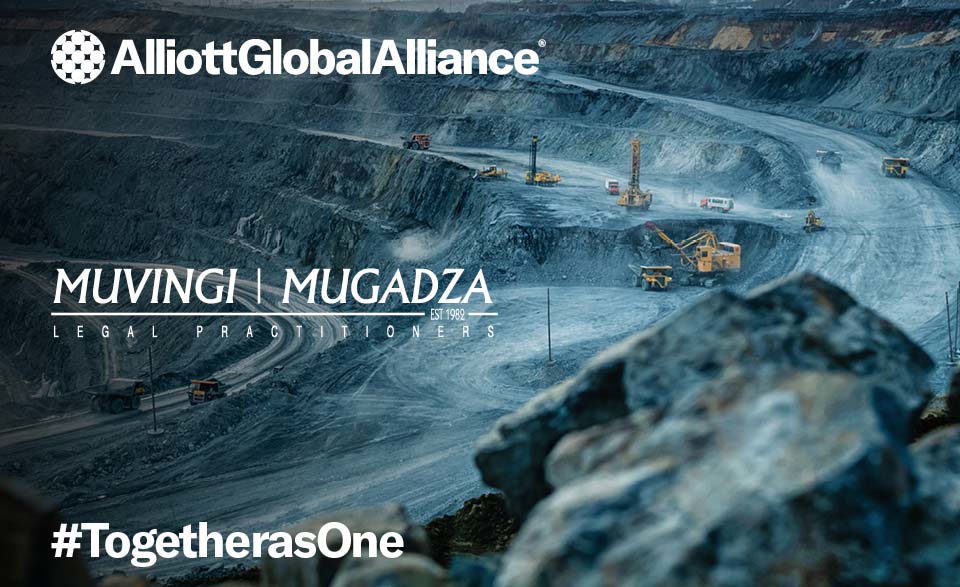Important changes to Zimbabwe's mining regulatory framework
01 December 2021
Here, Selina Zhuwarara, mining law expert and Consultant at Alliott Global Alliance law firm member Muvingi & Mugadza explains why Zimbabwe is re-structuring its policies and regulatory framework to improve investment and productivity in this up and coming sector.

1. INTRODUCTION
Zimbabwe has a permanent seat in the global mineral resources sector with various minerals such as gold, diamonds, the platinum group of metals, lithium, chrome, natural gas, uranium, coal, copper, nickel, iron ore, tantalite, dimension stones and graphite, among others. Since 2018 Zimbabwe has re-focused its attention on maximising the mining industry's potential, thus re-structuring its policies and regulatory framework to improve investment and productivity.
The mining regulatory framework in Zimbabwe is relatively straightforward. Mineral rights are vested in the President, who primarily administers these rights through the structures and institutions under the Ministry of Mines and Mining Development. Any person above 18 years of age permanently resident in Zimbabwe or a company duly registered in Zimbabwe can acquire mining rights in Zimbabwe. Mining entities can be 100% privately owned by investors. There are no current gazetted minerals falling under indigenisation requirements in terms of the Indigenization and Economic Empowerment Act Chapter 14:33 as read with section 36 of the Finance Act (No. 2) (No. 10 of 2020).
There are significant opportunities in exploration, green and brownfield mining projects, and beneficiation in the large and small-scale mining sectors. Approximately 25 Exclusive Prospecting Orders have been gazetted through General Notice 328 of 2021 within this year. Mining projects can also apply and be granted Special Economic Zone (SEZ) status, which comes with various fiscal and regulatory incentives. The government has also decidedly embarked on strategic private partnerships for its mining assets to re-capitalise and improve the productivity of mining assets held by the state.
Key institutions for mining investors include the Ministry of Mines and Mining Development, Zimbabwe Investment and Development Agency (ZIDA), Zimbabwe Mining Development Corporation (ZMDC), Zimbabwe Chamber of Mines and the Zimbabwe Geological Survey (ZGS). ZIDA is expressly set up to streamline the investment process by assisting investors in facilitating and coordinating the necessary registrations and clearances required in setting up investments in Zimbabwe. All foreign investors must incorporate a locally registered company with the Registrar of Companies and acquire an Investment License from ZIDA.
The Mining industry in Zimbabwe is regulated primarily through the Mines and Minerals Act Chapter 21:05 and other key statutes and regulations. Some of the main Statues and instruments covering operations, taxes, labour and environmental management and specific commodities include:

2. KEY REGULATORS
Key Mining Regulatory Authorities include:

3. LOCAL STOCK EXCHANGE LISTING REQUIREMENT
The government of Zimbabwe announced in April 2018 that it would not require new mining investors to list on the local stock exchange. However, the establishment of the Victoria Falls Exchange (VFEX), a subsidiary of the Zimbabwe Stock Exchange, through Statutory Instrument 196 of 2020 has created a platform for non-resident entities to raise capital from offshore sources. The Exchange creates an avenue for the mining companies to duly raise and trade capital and stock respectively in United States Dollars or any other convertible currency within the terms allowed by the Exchange.
4. TYPES OF MINING RIGHTS
The following constitute the main types of mining rights available in Zimbabwe.

5. MINING LICENSE FEES
Statutory Instrument 185 of 2021 currently sets the prevailing Licensing fees for the acquisition of various mining rights.
6. ROYALTIES & MAIN TAXES
Royalty rates are set through the Finance Act and are paid in foreign currency. The prevailing rates are as follows:

7. GENERAL TAX/ REGULATORY OVERVIEW
As with any mining jurisdiction, there are several taxes which are applicable to mining entities. Some of the key taxes or regulatory costs include:
8. SOCIAL LICENCE TO OPERATE
As with any other mining jurisdiction, Zimbabwe has incorporated community consultation procedures within its procedures of acquiring mining rights. Under the Environmental Management Act, the Environmental Impact Assessment (EIA) is a core deliverable in the assessment of applications for mining rights. The EIA is an assessment of the possible environmental, social, and economic impact of a proposed project. Before mining rights are issued, the miner must commission the EIA and exhaustively investigate both positive and negative impacts and proffer remedies to addressing the negative impacts. Consultation with communities is a key feature of the EIA and if executed well, it positively guides the relationship and expectations between the mining entities and communities.
The author, Selina Zhuwarara, is a mining law expert and Consultant at Muvingi & Mugadza with an LLB (honours) from the University of Zimbabwe, an Executive Masters in Business Administration from Africa University, Zimbabwe, and an LLM in Extractive Industry Law in Africa (University of Pretoria, South Africa).
For further information or assistance in the first instance please contact Nobert Phiri at phiri@mmmlawfirm.co.zw
Further reading:
About Muvingi Mugadza Legal Practitioners:
Leading, Dynamic and Innovative.
Muvingi & Mugadza Legal Practitioners is a distinguished law firm whose expertise and practice has continued to expand and evolve over the years to meet its clients’ requirements. Formed in 1982 the experienced and specialised legal practitioners at the firm offer the full range of legal services and are committed to delivering them in line with the firm values, those being, integrity, excellence, respect and innovation.

